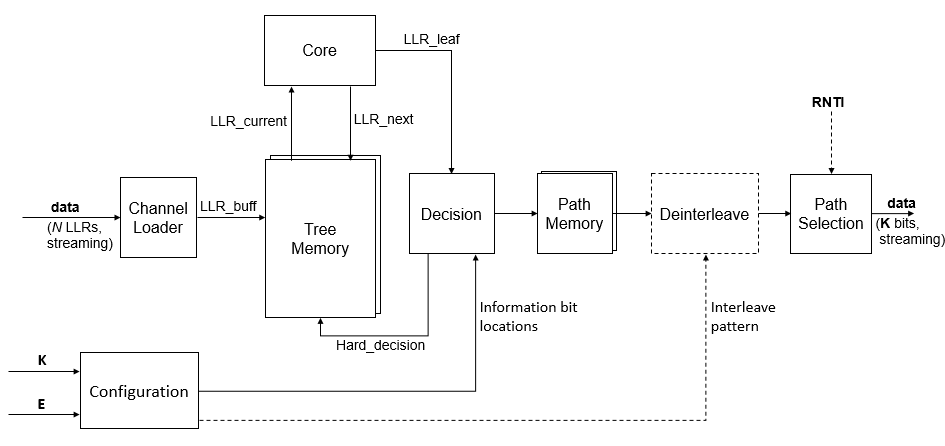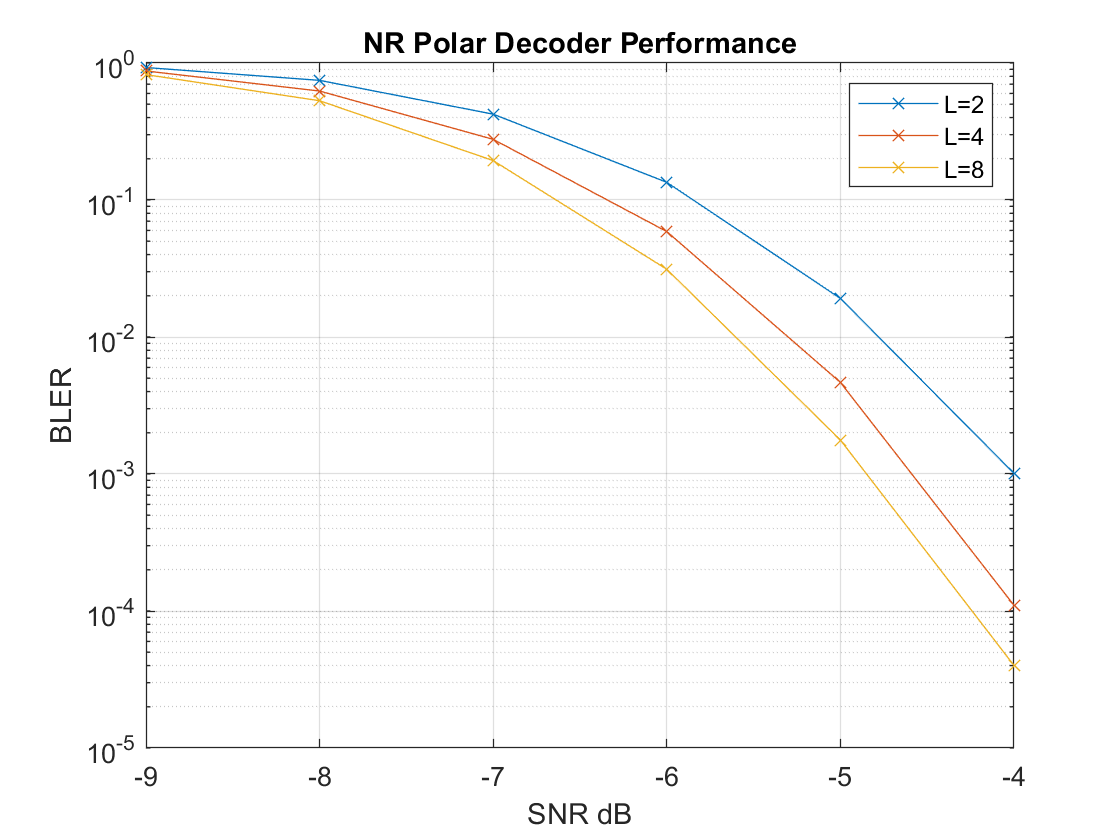expand all
This block implements a CRC-aided successive-cancellation list decoder. It can use a list
length of 2, 4, or 8 as configured by the List length parameter. The
decoder iterates over all LLRs in the tree to reach a decision for a bit and then uses that
decision to decode the next bit. The deinterleaving step is included only when you set the
Link direction parameter to Downlink.
This diagram shows the architecture of the polar decoder.
The block uses the Configuration stage when the K and
E input port values change. The block computes the locations of the
information bits and passes them to the Decision stage. Because the mapping patterns are
computed as needed, rather than stored in hardware, the block supports all
K and E values within the supported range. The
Configuration stage also computes the interleave pattern when you set the Link
direction parameter to Downlink.
When you set the Configuration source parameter to
Property, the K and E
values are constants, so the decoder does not implement the Configuration stage. In this case,
the block includes static lookup tables that contain the precomputed configuration.
To minimize computations for each decode, the Tree Memory stores the probability of each
node being a one or a zero. Each iteration updates only the LLRs that have changed. The Core
decoding stage uses the LLR update equations from [3].
The Decision stage checks the LLR value against the expected locations of information bits
and frozen bits and returns a hard decision to the Tree Memory. If the bit is expected to be
frozen, the Decision stage returns a hard decision of zero and updates the probabilities of
related paths. The Path Memory reconstructs the most likely paths from the hard decision
results and passes the paths and scores to the next stage.
Tree Memory and Path Memory contain up to List length paths. If all
frozen bits on a path are zeros (as expected), then the block discards the other parallel
paths. This optimization results in variable latency in the decoding operation for list
lengths greater than two. For signals with a high noise level, the decoder must increase the
number of parallel paths and the cycles for decoding. For low-noise signals, the decoder can
use only two parallel paths and reduce the decoding latency.
The Path Selection stage computes the CRC for all paths and then chooses the path that
passes the CRC. When you use the RNTI input port, the block compares the
internal CRC checksum with the target RNTI value. Otherwise, the block compares the CRC
checksum against a value of 0. If all CRCs fail, the block returns the path that has the
higher score.
This implementation matches the performance of the 5G Toolbox™ function nrPolarDecode (5G Toolbox) with the same list
length. Because the block uses fixed-point internal types, any differences are a result of
quantization.
This plot shows the block error rate performance with the three possible list lengths. The
input is 6-bit LLR values.
The table shows example latencies of the NR Polar Decoder block for each
N, when decoding for uplink and downlink channels with a list length of
two. N is the power-of-two encoded message length determined from the
values of K and E.
| N | Uplink Latency | Downlink Latency |
|---|
| 32 | 349 | Not applicable |
| 64 | 576 | 677 |
| 128 | 1034 | 1135 |
| 256 | 1961 | 2062 |
| 512 | 3896 | 3996 |
| 1024 | 8202 | Not applicable |
The exact latency varies based on the values of K and
E. The latency is longer for frames where the K
and E input port values change and the block must compute the new
configuration.
Increasing the list length increases the latency. List lengths greater than two do not
have a fixed latency for given K and E values. To
provide minimal latency, the block traces more than 2 paths only when the frozen bits are
not decoded as zeroes. This optimization means that the latency can increase with the SNR of
the input signal. For example, for a list length of 4 and N=512, the best
case latency is 4108 cycles, and the worst case latency is 4985 cycles.
Because the latency varies, use the output nextFrame control signal
to determine when the block is ready for a new input frame.
This waveform shows how the latency varies with the K and
E input port values for a list length of two. When the input
K and E port values are 132 and 256, the block
has a latency of 2272 cycles from the input start signal to the output
nextFrame. When the K and E
port values change to 54 and 124, the latency changes to 1234 cycles.
This waveform shows how the latency can vary with the noise level of the input signal
when using a list length of 4. The block has K and
E parameter values of 132 and 256 and Link
direction parameter set to Uplink. The first message
has a latency of 2533 cycles. This message data is generated with low noise and has few bit
errors. In this case, the decoder can collapse to two paths and produce a result in fewer
cycles than when decoding a noisier signal. The second message is generated with a high
noise level, and the decoding latency increases to 3174 cycles. When the input signal has
more bit errors, the decoder must trace more paths to determine the correct bits.
This table shows the resource and performance data synthesis results of the block when
it is configured with K and E as input ports, the
Link direction parameter set to Downlink,
and 6-bit input LLRs. The generated HDL is targeted to an AMD®
Zynq®-7000 ZC706 evaluation board. The design achieves a clock frequency of 250
MHz.
| Resource | List Length of 2 | List Length of 4 | List Length of 8 |
|---|
| Slice LUTs | 3048 | 4725 | 9963 |
| Slice Registers | 2509 | 3804 | 6471 |
| DSP48 | 0 | 0 | 0 |
| Block RAM | 4.5 | 5.5 | 6.0 |
The block uses fewer resources when K and E
are specified by parameters. When you set the Link direction parameter
to Uplink, the block uses more memory to accommodate larger
message sizes.




